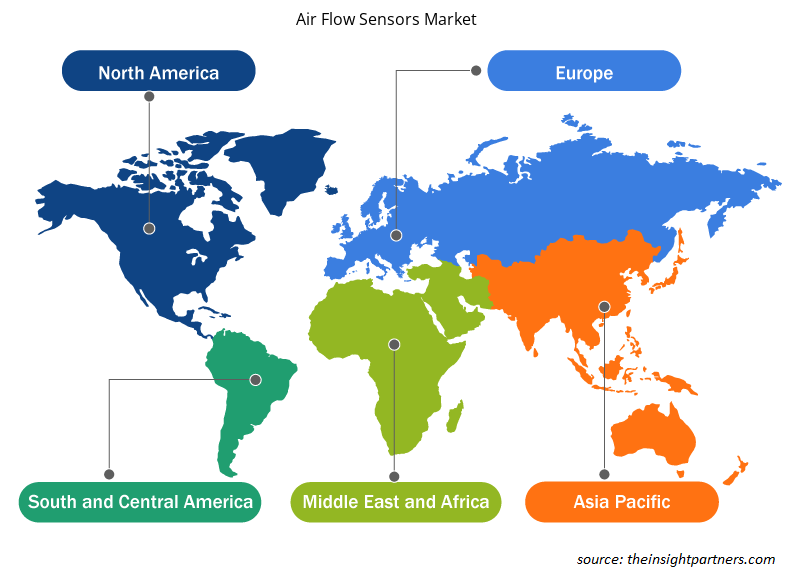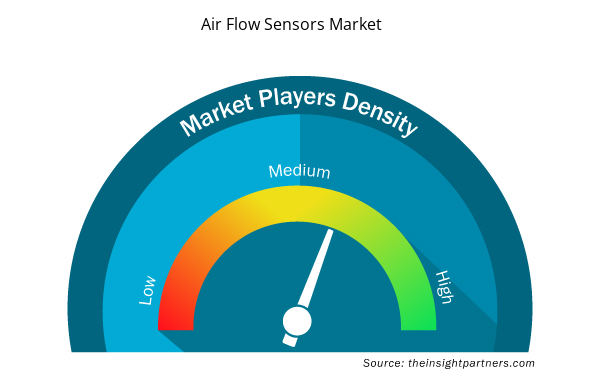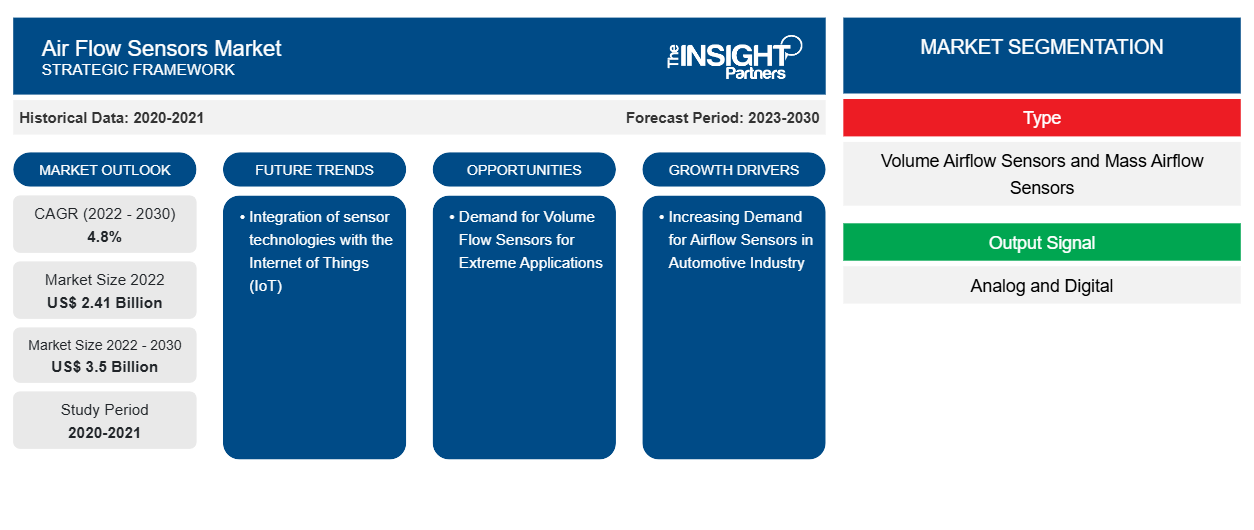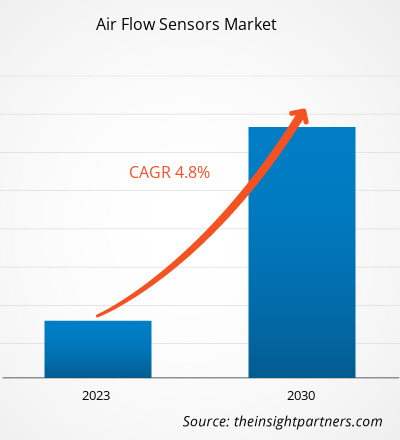エアフローセンサーの市場規模は、2022年の24億1,000万米ドルから2030年には35億米ドルに達すると予測されています。市場は2022年から2030年の間に4.8%のCAGRを記録すると予想されています。センサー技術とモノのインターネット(IoT)の統合は、市場の主要なトレンドであり続けると思われます。
エアフローセンサー市場分析
HVACシステムは、効率的な動作を保証し、エネルギー消費を削減するために、気流センサーを使用します。HVACシステムには気流センサーがあり、エリアの実際の温度と目標温度を比較して適切な措置を講じることができます。HVAC制御は、ホスピタリティ、企業、小売、住宅など、さまざまなビジネス分野で頻繁に使用されています。
エアフローセンサー市場の概要
エアフロー センサーは、チャネル内の空気の流量または質量を測定するために使用されます。エアフロー センサーには、質量エアフロー センサーと体積エアフロー センサーの 2 つのカテゴリがあります。エアフロー センサーは簡単に設置でき、全体の圧力、空気流の静圧、および空気の速度を測定します。エアフロー センサーは、幅広い産業システムで使用されています。自動車では、エアフロー センサーは最適な燃料効率と排出レベルを維持するために不可欠であり、エンジン制御ユニットが燃料噴射を調整して効率的な燃焼を確保するのに役立ちます。
要件に合わせてレポートをカスタマイズする
このレポートの一部、国レベルの分析、Excelデータパックなど、あらゆるレポートを無料でカスタマイズできます。また、スタートアップや大学向けのお得なオファーや割引もご利用いただけます。
- このレポートの主要な市場動向を入手してください。この無料サンプルには、市場動向から見積もりや予測に至るまでのデータ分析が含まれます。
エアフローセンサー市場の推進要因と機会
自動車業界でのエアフローセンサーの需要増加が市場を有利に導く
自動車業界は、エアフローセンサーの主要なエンドユーザーです。自動車の需要が高まると同時に、エアフローセンサーの必要性も高まります。これらのセンサーは、エンジンや排気システムで空気の流れを監視および制御するために使用されます。自動車業界は世界中で急速に成長しています。また、世界中でEVの普及が大幅に増加しています。欧州委員会によると、自動車業界は1,380万人のヨーロッパ人に直接的および間接的な雇用を提供し、ヨーロッパ全体の雇用の15.1%を占めています。欧州運輸環境連盟が引用した統計によると、英国政府は2050年までにネットゼロ排出の目標を掲げ、2035年までにすべての汚染車両の販売を禁止することを提案しました。したがって、ネットゼロ排出の取り組みと消費者の環境に優しい車両に対する需要が、エアフローセンサー市場を牽引しています。
極限用途向け体積流量センサーの需要
自動車、航空宇宙、製造、電力・公益事業などの多くの業界では、過酷な条件に耐える体積流量センサーが強く求められています。このため、市場プレーヤーは過酷な用途向けの体積流量センサーの開発を促しています。たとえば、2023 年 9 月、ENVEA は過酷な用途向けの体積流量センサーの高温バージョンであるAirFlow Pを発表しました。AirFlow P は、最大 800 °C の高温用途に適した、ダスト負荷センサーの体積流量測定用センサーです。
エアフローセンサー市場レポートのセグメンテーション分析
空気流量センサー市場分析の導出に貢献した主要なセグメントは、タイプとアプリケーションです。
- タイプに基づいて、気流センサー市場は体積気流センサーと質量気流センサーに分けられます。体積気流セグメントは2022年に大きな市場シェアを占めました。
- アプリケーションに基づいて、市場は自動車、航空宇宙、製造、電力およびユーティリティ、その他に分かれています。自動車セグメントは2022年に大きな市場シェアを占めました。
地域別エアフローセンサー市場シェア分析
空気流量センサー市場レポートの地理的範囲は、主に北米、アジア太平洋、ヨーロッパ、中東およびアフリカ、南米および中米の 5 つの地域に分かれています。
日本、インド、中国、オーストラリア、シンガポール、台湾、インドネシアなどの国には、電子機器、食品・飲料、化学、繊維、自動車、ヘルスケアなど、数多くの製造業があります。さらに、「Made in China 2025」や「Made in India」などの政府の取り組みにより、さまざまなアジア太平洋諸国でこれらの産業が活性化し、エアフローセンサーの需要が高まっています。さらに、中国では航空宇宙産業が急速に成長しています。北京の技術に精通した候補者と若い科学者のチームは、過去に嫦娥月探査機や天問火星探査などのミッションで重要な役割を果たしてきました。航空宇宙産業のこのような発展は、中国のエアフローセンサー市場の成長を牽引しています。さらに、空気の質を監視することの重要性に対する認識の高まりにより、アジア太平洋地域でのHVACシステムの需要が高まり、それによって同地域のエアフローセンサー市場に利益をもたらしています。
エアフローセンサー市場の地域別分析
予測期間を通じてエアフローセンサー市場に影響を与える地域的な傾向と要因は、Insight Partners のアナリストによって徹底的に説明されています。このセクションでは、北米、ヨーロッパ、アジア太平洋、中東およびアフリカ、南米および中米にわたるエアフローセンサー市場のセグメントと地理についても説明します。

- エアフローセンサー市場の地域別データを入手
エアフローセンサー市場レポートの範囲
| レポート属性 | 詳細 |
|---|---|
| 2022年の市場規模 | 24億1000万米ドル |
| 2030年までの市場規模 | 35億米ドル |
| 世界のCAGR(2022年 - 2030年) | 4.8% |
| 履歴データ | 2020-2021 |
| 予測期間 | 2023-2030 |
| 対象セグメント | タイプ別
|
| 対象地域と国 | 北米
|
| 市場リーダーと主要企業プロフィール |
|
市場プレーヤーの密度:ビジネスダイナミクスへの影響を理解する
空気流量センサー市場は、消費者の嗜好の変化、技術の進歩、製品の利点に対する認識の高まりなどの要因により、エンドユーザーの需要が高まり、急速に成長しています。需要が高まるにつれて、企業は提供を拡大し、消費者のニーズを満たすために革新し、新たなトレンドを活用し、市場の成長をさらに促進しています。
市場プレーヤー密度とは、特定の市場または業界内で活動している企業または会社の分布を指します。これは、特定の市場スペースに、その規模または総市場価値と比較して、どれだけの競合相手 (市場プレーヤー) が存在するかを示します。
エアフローセンサー市場で事業を展開している主要企業は次のとおりです。
- ハネウェルインターナショナル株式会社
- POSIFAマイクロシステムズ株式会社
- シーメンスAG
- 株式会社デンソー
- ボッシュ
- ディグリーコントロールズ株式会社
免責事項:上記の企業は、特定の順序でランク付けされていません。

- エアフローセンサー市場のトップキープレーヤーの概要を入手
エアフローセンサー市場のニュースと最近の動向
エアフローセンサー市場は、主要な企業出版物、協会データ、データベースなどの一次調査と二次調査後の定性的および定量的データを収集することによって評価されます。エアフローセンサー市場におけるいくつかの開発を以下に示します。
- 環境モニタリング ソリューションの大手プロバイダーである ENVEA は、最高 800 °C の温度に耐えられる高温バージョンの導入により、AirFlow P センサー シリーズの拡張を発表しました。この追加により、AirFlow P センサーの機能が拡張され、さらに困難な産業用途に最適なソリューションになります。(出典: ENVEA、企業 Web サイト、2023 年 9 月)
- Posifa Technologies は、呼吸ケアやその他のヘルスケアおよび計測目的で使用される質量空気流量センサーの最新バージョンを発表しました。PMF83000 および PMF86000 シリーズのセンサーは、湿度が高く、腐食性ガスのレベルが低い厳しい環境での使用を目的としています。(出典: Posifa Technologies、企業 Web サイト、2021 年 4 月)
エアフローセンサー市場レポートの対象範囲と成果物
「エアフローセンサー市場規模と予測(2020〜2030年)」レポートでは、以下の分野をカバーする市場の詳細な分析を提供しています。
- 対象範囲に含まれるすべての主要市場セグメントについて、世界、地域、国レベルでの空気流量センサー市場規模と予測
- 空気流量センサー市場の動向、および推進要因、制約、主要な機会などの市場動向
- 詳細なPEST/ポーターの5つの力とSWOT分析
- 主要な市場動向、世界および地域の枠組み、主要プレーヤー、規制、最近の市場動向を網羅した空気流量センサー市場分析
- 市場集中、ヒートマップ分析、主要プレーヤー、空気流量センサー市場の最近の動向を網羅した業界の状況と競争分析
- 詳細な企業プロフィール
- 過去2年間の分析、基準年、CAGRによる予測(7年間)
- PEST分析とSWOT分析
- 市場規模価値/数量 - 世界、地域、国
- 業界と競争環境
- Excel データセット


- Hair Wig Market
- Sterilization Services Market
- Single-Use Negative Pressure Wound Therapy Devices Market
- Emergency Department Information System (EDIS) Market
- Travel Vaccines Market
- Investor ESG Software Market
- Green Hydrogen Market
- Customer Care BPO Market
- E-Bike Market
- Retinal Imaging Devices Market

Report Coverage
Revenue forecast, Company Analysis, Industry landscape, Growth factors, and Trends

Segment Covered
This text is related
to segments covered.

Regional Scope
North America, Europe, Asia Pacific, Middle East & Africa, South & Central America

Country Scope
This text is related
to country scope.
よくある質問
The global air flow sensors market is expected to reach US$ 3.50 billion by 2030.
The global air flow sensors market is estimated to register a CAGR of 4.8% during the forecast period 2022–2030.
Asia Pacific dominated the air flow sensors market in 2022.
Increasing demand for airflow sensors in the automotive industry is the major factors that propel the global air flow sensors market.
Integration of sensor technologies with the Internet of Things (IoT) to play a significant role in the global air flow sensors market in the coming years.
The key players holding majority shares in the global air flow sensors market are Honeywell International Inc., POSIFA Microsystems Inc., Siemens AG, Denso Corporation, Bosch, Degree Controls Inc., TE Connectivity Corporation, CARDONE Industries, Sensirion AG Switzerland, and Analog Devices.
Trends and growth analysis reports related to Electronics and Semiconductor : READ MORE..
The List of Companies - Air Flow Sensor Market
- Honeywell International Inc.
- POSIFA Microsystems Inc.
- Siemens AG,
- Denso Corporation
- Bosch,
- Degree Controls Inc.
- TE Connectivity Corporation
- CARDONE Industries
- Sensirion AG Switzerland
- Analog Devices
The Insight Partners performs research in 4 major stages: Data Collection & Secondary Research, Primary Research, Data Analysis and Data Triangulation & Final Review.
- Data Collection and Secondary Research:
As a market research and consulting firm operating from a decade, we have published and advised several client across the globe. First step for any study will start with an assessment of currently available data and insights from existing reports. Further, historical and current market information is collected from Investor Presentations, Annual Reports, SEC Filings, etc., and other information related to company’s performance and market positioning are gathered from Paid Databases (Factiva, Hoovers, and Reuters) and various other publications available in public domain.
Several associations trade associates, technical forums, institutes, societies and organization are accessed to gain technical as well as market related insights through their publications such as research papers, blogs and press releases related to the studies are referred to get cues about the market. Further, white papers, journals, magazines, and other news articles published in last 3 years are scrutinized and analyzed to understand the current market trends.
- Primary Research:
The primarily interview analysis comprise of data obtained from industry participants interview and answers to survey questions gathered by in-house primary team.
For primary research, interviews are conducted with industry experts/CEOs/Marketing Managers/VPs/Subject Matter Experts from both demand and supply side to get a 360-degree view of the market. The primary team conducts several interviews based on the complexity of the markets to understand the various market trends and dynamics which makes research more credible and precise.
A typical research interview fulfils the following functions:
- Provides first-hand information on the market size, market trends, growth trends, competitive landscape, and outlook
- Validates and strengthens in-house secondary research findings
- Develops the analysis team’s expertise and market understanding
Primary research involves email interactions and telephone interviews for each market, category, segment, and sub-segment across geographies. The participants who typically take part in such a process include, but are not limited to:
- Industry participants: VPs, business development managers, market intelligence managers and national sales managers
- Outside experts: Valuation experts, research analysts and key opinion leaders specializing in the electronics and semiconductor industry.
Below is the breakup of our primary respondents by company, designation, and region:

Once we receive the confirmation from primary research sources or primary respondents, we finalize the base year market estimation and forecast the data as per the macroeconomic and microeconomic factors assessed during data collection.
- Data Analysis:
Once data is validated through both secondary as well as primary respondents, we finalize the market estimations by hypothesis formulation and factor analysis at regional and country level.
- Macro-Economic Factor Analysis:
We analyse macroeconomic indicators such the gross domestic product (GDP), increase in the demand for goods and services across industries, technological advancement, regional economic growth, governmental policies, the influence of COVID-19, PEST analysis, and other aspects. This analysis aids in setting benchmarks for various nations/regions and approximating market splits. Additionally, the general trend of the aforementioned components aid in determining the market's development possibilities.
- Country Level Data:
Various factors that are especially aligned to the country are taken into account to determine the market size for a certain area and country, including the presence of vendors, such as headquarters and offices, the country's GDP, demand patterns, and industry growth. To comprehend the market dynamics for the nation, a number of growth variables, inhibitors, application areas, and current market trends are researched. The aforementioned elements aid in determining the country's overall market's growth potential.
- Company Profile:
The “Table of Contents” is formulated by listing and analyzing more than 25 - 30 companies operating in the market ecosystem across geographies. However, we profile only 10 companies as a standard practice in our syndicate reports. These 10 companies comprise leading, emerging, and regional players. Nonetheless, our analysis is not restricted to the 10 listed companies, we also analyze other companies present in the market to develop a holistic view and understand the prevailing trends. The “Company Profiles” section in the report covers key facts, business description, products & services, financial information, SWOT analysis, and key developments. The financial information presented is extracted from the annual reports and official documents of the publicly listed companies. Upon collecting the information for the sections of respective companies, we verify them via various primary sources and then compile the data in respective company profiles. The company level information helps us in deriving the base number as well as in forecasting the market size.
- Developing Base Number:
Aggregation of sales statistics (2020-2022) and macro-economic factor, and other secondary and primary research insights are utilized to arrive at base number and related market shares for 2022. The data gaps are identified in this step and relevant market data is analyzed, collected from paid primary interviews or databases. On finalizing the base year market size, forecasts are developed on the basis of macro-economic, industry and market growth factors and company level analysis.
- Data Triangulation and Final Review:
The market findings and base year market size calculations are validated from supply as well as demand side. Demand side validations are based on macro-economic factor analysis and benchmarks for respective regions and countries. In case of supply side validations, revenues of major companies are estimated (in case not available) based on industry benchmark, approximate number of employees, product portfolio, and primary interviews revenues are gathered. Further revenue from target product/service segment is assessed to avoid overshooting of market statistics. In case of heavy deviations between supply and demand side values, all thes steps are repeated to achieve synchronization.
We follow an iterative model, wherein we share our research findings with Subject Matter Experts (SME’s) and Key Opinion Leaders (KOLs) until consensus view of the market is not formulated – this model negates any drastic deviation in the opinions of experts. Only validated and universally acceptable research findings are quoted in our reports.
We have important check points that we use to validate our research findings – which we call – data triangulation, where we validate the information, we generate from secondary sources with primary interviews and then we re-validate with our internal data bases and Subject matter experts. This comprehensive model enables us to deliver high quality, reliable data in shortest possible time.


 このレポートの無料サンプルを入手する
このレポートの無料サンプルを入手する